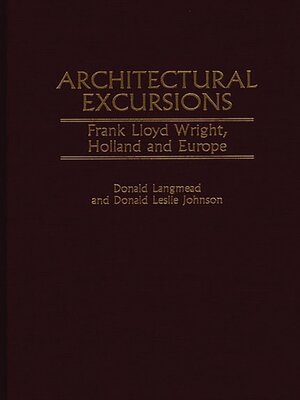Architectural Excursions
ebook ∣ Frank Lloyd Wright, Holland and Europe · Contributions to the Study of Art and Architecture
By Donald L. Johnson

Sign up to save your library
With an OverDrive account, you can save your favorite libraries for at-a-glance information about availability. Find out more about OverDrive accounts.
Find this title in Libby, the library reading app by OverDrive.



Search for a digital library with this title
Title found at these libraries:
| Library Name | Distance |
|---|---|
| Loading... |
Soon after 1900 in both North America and Europe the evolution from the tradition of Mediterranean and Gallic architectural styles to modernism began. This phenomenon was due, in part, to American industrial architecture and the work of Frank Lloyd Wright. Wright's building and architectural treatises of 1898-1908, with the additional help of Dutch propaganda on his behalf, significantly influenced European practitioners and theorists. European architecture within and outside of Holland reflects an adaptation of Wright's theories along with the structural determinism of American industrial buildings. With new evidence and fresh analysis culled from Dutch and American archives, personal correspondence, and professional material, this study examines the weight of Wright's works and words and those of the Dutchmen H.P. Berlage, Theo van Doesburg, Jan Wils, J.J.P. Oud, William Dudok, and Hendrik Theodor Wijdeveld.
This new insight on the effects of Wright's architectural theories and designs, coupled with an extensive guide for further research, will attract art and architecture scholars and historians on both sides of the Atlantic and will also be of interest to social historians, artists, and architects. Events and new theories, including the assertion that Hendrik Theodor Wijdeveld was the catalytic source behind Wright's Taliesin Fellowship established in 1932, are presented in clear accessible language. Tied to the text are numerous visual presentations of significant designs and buildings.
This new insight on the effects of Wright's architectural theories and designs, coupled with an extensive guide for further research, will attract art and architecture scholars and historians on both sides of the Atlantic and will also be of interest to social historians, artists, and architects. Events and new theories, including the assertion that Hendrik Theodor Wijdeveld was the catalytic source behind Wright's Taliesin Fellowship established in 1932, are presented in clear accessible language. Tied to the text are numerous visual presentations of significant designs and buildings.







